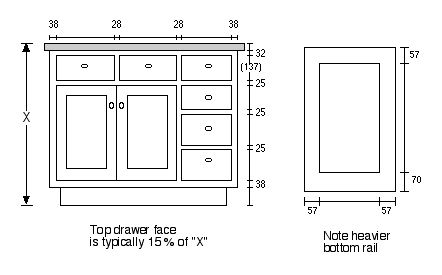Question
In the past I have been building exclusively overlay face frame cabinets, but lately I have been getting some inset door jobs. For the overlay doors I have been making all perimeter rails and stiles 1-3/4 inches and all middle stile and rails at 2-1/4 inches, so I end up with 1-1/4 inch of all of the stiles and rails exposed with my 1/2 inch overlay doors. I have used the same stile and rail width on the first few inset jobs out of habit but it seems like they are too wide proportionally with the inset doors, so now I have gone to using all 1-1/4 inch stiles and rails and it looks better. What sizes are the rest of you using? So far I haven't done any beaded frames.
Forum Responses
(Cabinetmaking Forum)
From contributor A:
I use 1-1/2" for all stiles and mid rails, regardless of frame style. For overlay jobs, the reveal between all doors/drawers is 1/2". On beaded inset, the bead amount is added to the 1-1/2" width, which is usually 3/8" with the 1/4" bead normally used.
Where we use 57 mm for a shaker door we switch to 64mm for an ogee door. Note that the top drawer is typically 15% of the overall floor to counter height. This is a percentage that works well with counters that are 36-37 or 38 inches tall. This is also the number that drives everything else. The holes for our drawer slides always situate 37 mm from the top side of the bottom face frame element. This way you can interchange Blum Tandem slides with Accuride Side Mount slides. The important thing is to develop a system for your math. Figure out what looks good then get good at reproducing that.
Once you start doing flush inset you will discover some other advantages. Your doors and drawer face alignments only have to look good within the context of one opening at a time. This is different than making a matrix of a dozen door or drawer faces line up across a room. Beaded face frames are easiest of all because it's really hard to see an alignment problem when you juxtapose square edges to round corners. Beaded face frame cabinets also sell for more money.
